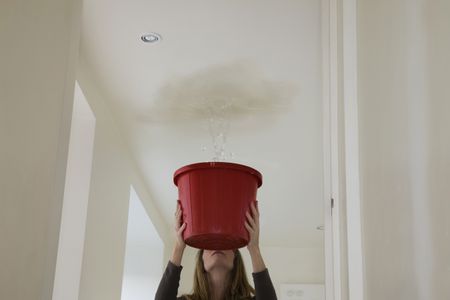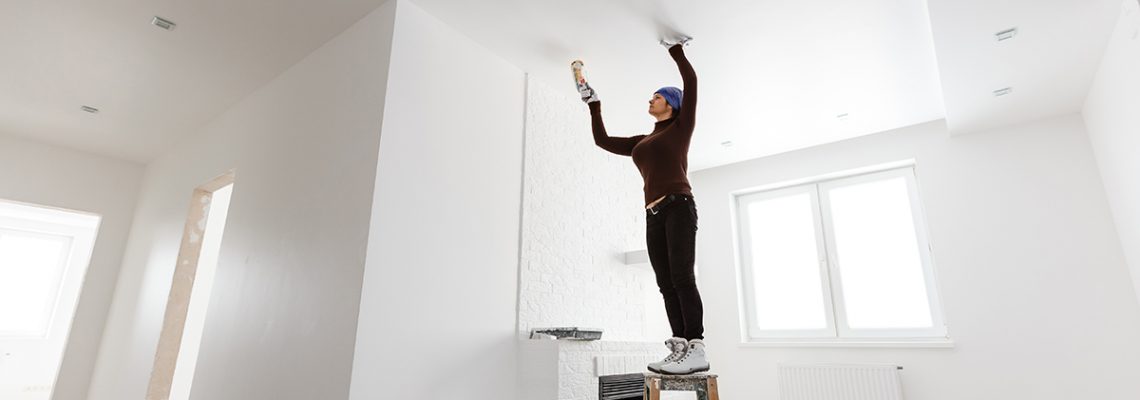Are you freaking out because of a leak in your ceiling?
Considering how damaging such a leak can be to the interior of your home, your freaking is totally understandable. The leaking point is, in most case, meters away from the actual point where the water is entering the ceiling which makes investigating the source a very frustrating ordeal. Don’t lose hope just yet though as we are here to help you identify the source of- and fix- your ceiling leaking problem. Please be our guest.
 What Are the Common Causes of Ceiling Leaks?
What Are the Common Causes of Ceiling Leaks?
Leaks in the roof are the most probable sources of water which later leaks from the ceiling. That is, however, not to mean that you should rush to the roof every time you notice a water drop from your ceiling. There are several other probable leak sources that you ought to check out first before making your conclusions. Some of them include plumbing leaks and air conditioning leaks.
How To Differentiate Between a Roof Leak And A Plumbing/An Air Conditioning Leak.
There are only two ways to tell: observing the ceiling leak patterns or climbing to the attic and following the water trails to their source(s). If, after observing the leak patterns, you realize that the water drops are dirty, there is a high chance that the leak is coming from the roof. The same probability applies to when the leaks come during or immediately after the rains and cease during the dry seasons. If, on the other hand, you notice a leak during a dry season, chances are that the leak source is from within the interiors and not the roof. Another characteristic of plumbing/air conditioning leaks is that their drops are mostly clean.
Although observing the leaking patterns can give you a clue of what the leak source is, it’s always wise to access the attic and confirm the validity of that clue. Sometimes rainwater from a roof leak can pool in the ceiling and stay there for months, only for pests to scratch the ceiling and provide the water with an escape route. If that happens during a dry season, you might end up making the wrong conclusion that the water is from a plumbing line.
Important note
If you saw some unexpected standing water or wetness in your home but didn’t see any water drop(s) falling from the ceiling, it is advisable not to conclude that there is a leak in the ceiling without first checking for water leaks within the home. You may need to check for leaks in the water heater, the washing machine, under water sinks, and any appliance that uses water. It’s only after confirming that none of those sources is leaking that you check the ceiling/attic. That being said, how do you locate the leak source from the attic?
Locating Sources of a Ceiling Leak from the Attic.
Always begin your leak investigations by measuring/approximating the distance between the leak and a fixed reference point in your living area. That could be a wall, a chimney, or a vent pipe for bathrooms. This distance will help you to easily locate the ceiling leak while in the attic; you will be on top of it at that time and locating it is definitely not the easiest thing to do. That done, take your flashlight, a plastic straw, and any other safety equipment that you might need while up there and, using a ladder, climb up to the attic.
The flashlight will help you to locate where the ceiling leak is which will then help you to follow the water trail/stain from the leaking point to its source. If there is a water supply pipe at the end of the trail, check it to see if it could be the source of the leaking water. If it’s moist, you definitely have solved the puzzle. Repair it or call a professional plumbing company to do it for you. If it isn’t, check if there are any holes in the roof. The easiest way of detecting a hole in the roof is looking for light spots on the attic ceiling. If you see one, insert a straw to mark the hole so that you can easily locate it from the other side of the roof.
What if you can’t see any holes in the roof even after confirming that all the plumbing lines are intact? Then it’s time to climb to the roof and check if there are:
• Spaces between sidings or shingles that could be causing the leak.
• Any unsealed parts around the chimney, valley, or attic dormer vents.
• Clogged gutters or any foreign material on the roof.
• Any signs of tear and wear in all protrusions on the roof.
If you identify the source, fix it using tar or any other roofing material. If you can’t, contact a professional plumbing or roofing company.
Conclusion
A leak in the ceiling is arguably the most disturbing thing that can happen to a homeowner, particularly during wet seasons? Are you struggling with a ceiling leak in Knoxville, Tennessee? Have you identified the leak source but, for whichever reason, you are unable to fix it? Knoxville Plumbing is here to help. Our plumbers are experienced and dedicated to fixing all of your leaking problems. Give us a call. If you have determined it is a roofing leak call the best roofing company in Knoxville, TN.



